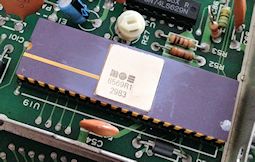Commodore 64
Hardware
The C64 was the revolution at this time. Have a look at his important components (in square brackets the IC type which is on the newer motherboards):
- MOS 6510 [8500] CPU, running at ~1MHz
- 64KB RAM system (38 KB BASIC RAM, 16 KB ROM, 4KB char ROM and some other stuff)
- MOS 6567 [8562] (NTSC) / 6569 [8565] (PAL) video interface controller, called VIC-II
- MOS 6581 [8580] sound interface device, SID
- Two MOS 6526 complex interface adapters, CIA
This is the motherboard of my C64, containing all the "old" types of the ICs. Specially we have revision 1 of the VIC-II in a ceramic case and gold plated pins. Hover with your mouse to see where the ICs mentioned above are located. Click on pictures to enlarge.

|
 |
And here are the I/O-ports, from left to right as seen on the picture (picture from my C64C, but identical to C64)

- Game ports - there are two game ports, were you can connect joystick, mouse, light pen and paddles.
- Power switch
- Power connector
- Expansion port - here you can insert game-modules and other expansions
- here would be the TV channel selector, but it is not available on the European version
- Antenna output for connecting the C64 to the TV
- Video/Audio - here you can connect the C64 to a video monitor and/or to a Hi-Fi-System
- Serial - the serial bus of the C64. For diskette drives and printers.
- Cassette - you can connect a cassette drive for storing data
- User port - a free programmable I/O-port for other peripherals, RS-232-port
The VIC-II features 40x25 characters, 320x200 graphic resolution in hires-mode (each 8x8 field can contain a separate fore- and background-color out of 16), 160x200 graphic resolution in multi-color-mode (each 8x8 field can contain pixels with four different colors, out of 16). Additional it can display up to eight "movable object blocks", also called SPRITES. A SPRITE has 24x21 resolution, and can be in hires or multi-color. The VIC supports horizontal and vertical "smooth" scrolling and a light pen.
The SID was specially designed for the C64. It supports three independent voices, four different waveforms which can generate tones from 0-4kHz and three different filters. You can program the attack/decay/sustain/release of each tone. Additional the SID has two A/D-converters, they are for the two potentiometers (called paddles) which you can connect to the gameports.
 The SID
The SID
The two CIAs control the keyboard, the two game-ports and of course the serial port and the user port. The CIA also offers a real time clock.
Now let's see what's the C64 power-on-screen:

The C64 welcomes you with these more or less beloved colors.
But this color-combination is good, because even on a bad TV you have a readable screen. The C64 generates a UHF signal on channel 36 (in PAL, for Europe). The US C64 generates a VHF signal on channel 3 or 4 (in NTSC). You can also connect the C64 to a color monitor, which gives you a better picture (composite video signal). But the VIC generates another, much better luminance/crominance video signal, today known as S-Video (S-VHS/Hi8 system). With an according monitor you get the best picture.
But what can you do with the C64? I would simply say: EVERYTHING! First of all, BASIC. But, the C64 BASIC is not a very good BASIC. You can do the standard things like FOR ... TO Loops, IF ... THEN (without ELSE !), GOTO, GOSUB and other stuff, but there are NO graphic and sound commands. If you want to program hires graphics, sprites and sound, you have to POKE (write a value) direct into the registers of the corresponding IC, or use machine language.


